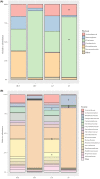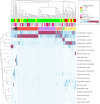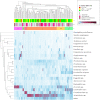Lactobacillus crispatus-dominated vaginal microbiome and Acinetobacter-dominated seminal microbiome support beneficial ART outcome
- PMID: 37221898
- PMCID: PMC10333654
- DOI: 10.1111/aogs.14598
Lactobacillus crispatus-dominated vaginal microbiome and Acinetobacter-dominated seminal microbiome support beneficial ART outcome
Abstract
Introduction: Despite the considerable progress made in assisted reproductive technologies (ART), the implantation rate of transferred embryos remains low and in many cases, the reasons for failure remain unclear. We aimed to determine the potential impact of female and male partners' reproductive tract microbiome composition on ART outcome.
Material and methods: The ART couples (n = 97) and healthy couples (n = 12) were recruited into the study. The smaller healthy group underwent a careful selection according to their reproductive and general health criteria. Both vaginal and semen samples were subjected to 16S rDNA sequencing to reveal the bacterial diversity and identify distinct microbial community types. Ethics statement The study was approved by the Ethics Review Committee on Human Research of Tartu University, Tartu, Estonia (protocol no. 193/T-16) on 31 May 2010. Participation in the research was voluntary. Written informed consent was obtained from all study participants.
Results: The men with Acinetobacter-associated community who had children in the past, had the highest ART success rate (P < 0.05). The women with bacterial vaginosis vaginal microbiome community and with L. iners-predominant and L. gasseri-predominant microbiome had a lower ART success rate than women with the L. crispatus-predominant or the mixed lactic-acid-bacteria-predominant type (P < 0.05). The 15 couples where both partners had beneficial microbiome types had a superior ART success rate of 53%, when compared with the rest of the couples (25%; P = 0.023).
Conclusions: Microbiome disturbances in the genital tract of both partners tend to be associated with couple's infertility as well as lower ART success levels and may thus need attention before the ART procedure. The incorporation of genitourinary microbial screening as a part of the diagnostic evaluation process may become routine for ART patients if our results are confirmed by other studies.
Keywords: assisted reproductive technologies (ART); couple; infertility; microbiome; reproductive tract; semen.
© 2023 The Authors. Acta Obstetricia et Gynecologica Scandinavica published by John Wiley & Sons Ltd on behalf of Nordic Federation of Societies of Obstetrics and Gynecology (NFOG).
Conflict of interest statement
The authors have stated explicitly that there are no conflicts of interest in connection with this article.
Figures






Similar articles
-
The vaginal microbiome as a predictor for outcome of in vitro fertilization with or without intracytoplasmic sperm injection: a prospective study.Hum Reprod. 2019 Jun 4;34(6):1042-1054. doi: 10.1093/humrep/dez065. Hum Reprod. 2019. PMID: 31119299
-
Associations between the vaginal microbiome and Candida colonization in women of reproductive age.Am J Obstet Gynecol. 2020 May;222(5):471.e1-471.e9. doi: 10.1016/j.ajog.2019.10.008. Epub 2019 Oct 22. Am J Obstet Gynecol. 2020. PMID: 31654610 Free PMC article.
-
[Characteristics and physiologic role of female lower genital microbiome].Orv Hetil. 2023 Jun 18;164(24):923-930. doi: 10.1556/650.2023.32791. Print 2023 Jun 18. Orv Hetil. 2023. PMID: 37330978 Review. Hungarian.
-
Genomic Comparisons of Lactobacillus crispatus and Lactobacillus iners Reveal Potential Ecological Drivers of Community Composition in the Vagina.Appl Environ Microbiol. 2016 Nov 21;82(24):7063-7073. doi: 10.1128/AEM.02385-16. Print 2016 Dec 15. Appl Environ Microbiol. 2016. PMID: 27694231 Free PMC article.
-
Vaginal microbiome.Ceska Gynekol. 2018 Winter;83(5):371-379. Ceska Gynekol. 2018. PMID: 30848142 Review. English.
Cited by
-
Contribution of the seminal microbiome to paternal programming.Biol Reprod. 2024 Aug 15;111(2):242-268. doi: 10.1093/biolre/ioae068. Biol Reprod. 2024. PMID: 38696371 Free PMC article. Review.
-
Female genital tract microbiome: the influence of probiotics on assisted reproduction.Rev Bras Ginecol Obstet. 2024 Dec 4;46:e-rbgo82. doi: 10.61622/rbgo/2024rbgo82. eCollection 2024. Rev Bras Ginecol Obstet. 2024. PMID: 39669302 Free PMC article. Review.
-
Exploring Immunome and Microbiome Interplay in Reproductive Health: Current Knowledge, Challenges, and Novel Diagnostic Tools.Semin Reprod Med. 2023 Sep;41(5):172-189. doi: 10.1055/s-0043-1778017. Epub 2024 Jan 23. Semin Reprod Med. 2023. PMID: 38262441 Free PMC article. Review.
-
Vaginal dysbiosis - the association with reproductive outcomes in IVF patients: a systematic review and meta-analysis.Curr Opin Obstet Gynecol. 2024 Jun 1;36(3):155-164. doi: 10.1097/GCO.0000000000000953. Epub 2024 Apr 5. Curr Opin Obstet Gynecol. 2024. PMID: 38597377 Free PMC article.
-
Male Tract Microbiota and Male Infertility.Cells. 2024 Jul 29;13(15):1275. doi: 10.3390/cells13151275. Cells. 2024. PMID: 39120306 Free PMC article. Review.
References
-
- Altmäe S, Franasiak JM, Mändar R. The seminal microbiome in health and disease. Nat Rev Urol. 2019;16:703‐721. - PubMed
MeSH terms
Grants and funding
LinkOut - more resources
Full Text Sources
Other Literature Sources
Miscellaneous

